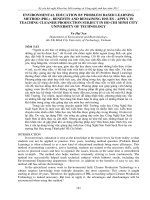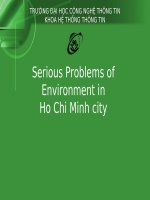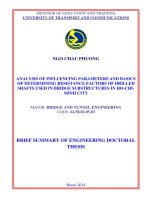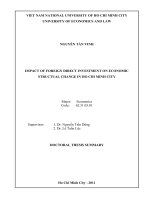Effects of short term exposure to air pollution on hospital admissions of young children for acute lower respiratory infections in ho chi minh city
Bạn đang xem bản rút gọn của tài liệu. Xem và tải ngay bản đầy đủ của tài liệu tại đây (108.27 KB, 4 trang )
The effects of short-term exposure on hospital admissions for acute lower respiratory
infections in young children of Ho Chi Minh City
Collaborative Working Group on Air Pollution, Poverty, and Health
in Ho Chi Minh City (HCMC)*
∗
In cooperation with an initiative of the Asian Development Bank, an interdisciplinary team of local and international experts is
conducting a unique program to assess the health effect of air pollution among the poor in Ho Chi Minh City (HCMC). The project
has two complementary components – a hospital-based study and a household-based study (discussed here). In the hospital study,
we estimate the effect of short-term exposure to air pollution on hospital admissions for acute lower respiratory infections in young
children (<5 years) in HCMC, and compare the magnitude of the effect of air pollution on poor children vs. other children. The
poor may experience higher actual exposures to air pollution than the non-poor, but this would not be reflected by the ambient
monitors used to assess exposure in the hospital study. Therefore, there is a need to assess the extent to which localized sources
may contribute to exposure measurement error arising from the use of ambient monitoring site data for estimating the health
impacts, particularly for different sub-groups. The objective of the household study is to assess determinants of personal exposure
for the poor and non-poor, and to explore whether the use of ambient monitors as a surrogate for personal exposures results in
differential exposure misclassification by socio-economic status (SES).
Specific Aims
1. To assess the effects of exposure to air pollution on hospitalization for ALRI of children under five years of age in HCMC
from 2003 - 2005 using time series and case crossover analyses. The study focused on the effects of daily average
exposure to PM10 and Ozone.
2. To compare the magnitude of the effect of air pollution on poor children versus other children in the case crossover
analysis using individual and group-level indicators of poverty status
Case Ascertainment
Admissions for pneumonia, bronchiolitis, and bronchitis in children less than five years of age were extracted from computerized
records of the two Children’s Hospitals (CH1 and CH2) of Ho Chi Minh City (HCMC). Nearly all children admitted for
respiratory illnesses in HCMC are hospitalized in one of these two pediatric hospitals. Thus, we captured nearly all children’s
admissions for acute respiratory illness in HCMC.
ALRI admissions by age, sex, and outcome category, 2003-2005
Children Hospital 1
N=(7462)
Children Hospital 2
(N=20263)
Combined
N=(28085)
Male 71.1%, (5305) 60.9%, (12550) 63.6%, (17855)
Female 28.9%, (2157) 39.1%, (8073) 36.4%, (10230)
0 36.6%, (2729) 23.6%, (4877) 27.1%, (7606)
1 37.6%, (2809) 40.0%, (8241) 39.3%, (11050
2 17.1%, (1277) 22.6%, (4657) 21.1%, (5934)
3 5.8%, (432) 8.5%, (1747) 7.8%, (2179)
4 2.3%, (175) 3.7%, (753) 3.3%, (928)
5 0.5%, (40) 1.7%, (348) 1.4%, (388)
Pneumonia 33.5%, (2501) 34.1%, (7023) 33.9%, (9524)
Bronchiolitis 43.1%, (3217) 16.8%, (3457) 23.8%, (6674)
Other ALRI 23.4%, (1744) 49.2%, (10143) 42.3%, (11887)
∗
Includes collaborators from the HCMC Department of Public Health, Environmental Protection Agency (HEPA), and the
Pediatric Hospitals, as well as the Health Effects Institute, Beth Israel Deaconess Medical Center, and the University of Hong
Kong.
Air Quality Data
Daily, city-level exposure estimates of particulate
matter with diameter less than 10 microns (PM10),
Ozone, NO2, and SO2 were generated using data
from the HCMC Environmental Protection
Agency’s (HEPA) ambient air quality monitoring
network. Daily meteorological information
including temperature and relative humidity were
collected from KTTV NB, the Southern regional
hydro-meteorological center.
Effect Modification by Socio-Economic Position (SEP)
• Individual indicators of SEP were based on degree of
payment exemption from the hospital financial
records.
• District-level estimates of poverty prevalence in
2004 were obtained from a poverty mapping
collaboration project of the Institute of Economic
Research and the World Bank. Poverty prevalence
was defined as the 6 million VND income poverty
line of set by the People’s Committee of HCMC.
Quartiles of district-level poverty incidence were
created based on the poverty prevalence estimates
for each district.
Average daily PM10 concentrations, 2003 – 2005
Analytic Approaches
Time-series analysis: The unit of observation is daily counts of hospital admissions for acute lower respiratory infection. We used
Poisson regression with smoothing functions for meteorologicalvariables, and variables for seasonal and long-term trends.
Distributed lag functions were used to examine the effect of pollutant and temperature lags.
Case-crossover analysis: The case period (the duration of time which a child with ALRI gets admitted to the hospital) was
defined to be 7 days before the admission date. The time-stratified control periods were defined using methods that compare
pollution levels on days before and after the admission period.
Results
Large seasonal differences in admission patterns and pollution levels were observed. Around 60% of ALRI admissions occur
during the rainy season, while the highest pollutant concentrations are observed in the dry season. Results differed markedly when
analyses were stratified by (rather than simply adjusted for) season.
Because there is variability (on the order of days) in the time between onset of illness and hospital admission, it was not possible to
definitively identify an appropriate single day lag. We focus on the results for lag 0 and average lag 0-5, which takes pollution
levels in the five days leading up to admission into account. Results were robust to differences in temperature lags, so only results
for ave lag 0-5 of temperature are presented.
In general, positive associations between increased ALRI admissions and pollutants (PM10, Ozone, NO2 and SO2 and Ozone)
were observed in the dry season, and negative associations were observed in the rainy season. With the exception of Ozone,
results were generally consistent across time series and case crossover analyses. Ozone, NO2 and SO2 effects were consistently
higher than PM effects, in both single pollutant and bipollutant models. Percent increases for the <1 age group tended to be larger,
likely due to the fact that this is the population most susceptible to pneumonia and bronchiolitis.
Preliminary results do not suggest that short term exposures to air pollution impact children from different SEP differently,
regardless of whether SEP is measured at the individual or district level. We are continuing to explore these relationships.
% increase in pneumonia and bronchiolitis hospitalizations,
Poisson analyses, by season, ages 0-5 years
PM
10
O
3
PM10
Percent change per 10 ug/m3
Lag0 Lag0-5 Lag0 Lag0-5
-10
-5
0
5
10
15
20 RAINY SEASON DRY SEASON
O3
Percent change per 10 ug/m3
Lag0 Lag0-5 Lag0 Lag0-5
-10
-5
0
5
10
15
20 RAINY SEASON DRY SEASON
NO
2
SO
2
NO2
Percent change per 10 ug/m3
Lag0 Lag0-5 Lag0 Lag0-5
-20
-10
0
10
20
30
40
50
60
70
80 RAINY SEASON DRY SEASON
SO2
Percent change per 10 ug/m3
Lag0 Lag0-5 Lag0 Lag0-5
-20
-10
0
10
20
30
40
50
60
70
80 RAINY SEASON DRY SEASON
PM
10
O
3
PM10
Percent change per 10 ug/m3
S C1 C2 C3 S C1 C2 C3
-10
-5
0
5
10
15
20 LAG 0 LAG 0-5
S: PM10 C1: PM10 + O3
C2: PM10 + NO2 C3: PM10 + SO2
O3
Percent change per 10 ug/m3
S C1 C2 C3 S C1 C2 C3
-10
-5
0
5
10
15
20 LAG 0 LAG 0-5
S: O3 C1: O3 + PM10
C2: O3 + NO2 C3: O3 + SO2
NO
2
SO
2
NO2
Percent change per 10 ug/m3
S C1 C2 C3 S C1 C2 C3
-20
-10
0
10
20
30
40
50 LAG 0 LAG 0-5
S: NO2 C1: NO2 + PM10
C2: NO2 + O3 C3: NO2 + SO2
SO2
Percent change per 10 ug/m3
S C1 C2 C3 S C1 C2 C3
-20
-10
0
10
20
30
40
50 LAG 0 LAG 0-5
S: SO2 C1: SO2 + PM10
C2: SO2 + O3 C3: SO2 + NO2
% increase in pneumonia and bronchiolitis hospitalizations, dry season,
ages 0-5 years – Poisson vs. case-crossover analyses
PM
10
O
3
PM10
Percent change per 10 ug/m3
SC1C2C3 SC1C2C3
-10
-5
0
5
10
15
20 LAG 0 LAG 0-5
S: PM10 C1: PM10 + O3
C2: PM10 + NO2 C3: PM10 + SO2
O3
Percent change per 10 ug/m3
S C1 C2 C3 S C1 C2 C3
-10
-5
0
5
10
15
20 LAG 0 LAG 0-5
S: O3 C1: O3 + PM10
C2: O3 + NO2 C3: O3 + SO2
NO
2
SO
2
NO2
Percent change per 10 ug/m3
S C1 C2 C3 S C1 C2 C3
-20
-10
0
10
20
30
40
50 LAG 0 LAG 0-5
S: NO2 C1: NO2 + PM10
C2: NO2 + O3 C3: NO2 + SO2
SO2
Percent change per 10 ug/m3
S C1 C2 C3 S C1 C2 C3
-20
-10
0
10
20
30
40
50 LAG 0 LAG 0-5
S: SO2 C1: SO2 + PM10
C2: SO2 + O3 C3: SO2 + NO2
PM
10
O
3
NO2
Percent change per 10 ug/m3
SC1C2C3 SC1C2C3
-10
-5
0
5
10
15
20
25 LAG 0 LAG 0-5
S: NO2 C1: NO2 + PM10
C2: NO2 + O3 C3: NO2 + SO2
O3
Percent change per 10 ug/m3
S C1 C2 C3 S C1 C2 C3
-10
-5
0
5
10
15
20
25 LAG 0 LAG 0-5
S: O3 C1: O3 + PM10
C2: O3 + NO2 C3: O3 + SO2
NO
2
SO
2
NO2
Percent change per 10 ug/m3
SC1C2C3 SC1C2C3
-10
-5
0
5
10
15
20
25 LAG 0 LAG 0-5
S: NO2 C1: NO2 + PM10
C2: NO2 + O3 C3: NO2 + SO2
SO2
Percent change per 10 ug/m3
S C1 C2 C3 S C1 C2 C3
-10
-5
0
5
10
15
20
25 LAG 0 LAG 0-5
S: SO2 C1: SO2 + PM10
C2: SO2 + O3 C3: SO2 + NO2
Co-pollutant models:
% increase in pneumonia and bronchiolitis hospitalizations, Poisson analyses, by season, ages 0-5 years
Dry Season
Rainy Season
Discussion
Preliminary results suggest that increased concentrations of air pollutants, PM10, Ozone, NO2 and SO2, are associated with
increased hospital admissions for ALRI in young children of HCMC, particularly in the dry season. While these analyses did not
suggest differential effects by socio-economic position, there are several reasons why the limitations in data available for this
analysis may be limit the ability to find such relationships:
• It is highly possible that poorer children systematically experience higher exposures to air pollution per unit of
reported air quality on any given day compared to non-poor children. Since in these analyses a single daily
measurement of pollution is assigned to all children for a particular day, however, it would not be possible to
estimate daily differences in exposure across socio-economic status in this component. The second component
of the study, which is underway currently and involves detailed monitoring of personal exposures, is designed to
better evaluate these different exposures.
• Differential effects at a given level of exposure could reflect differential susceptibility among poor children
mediated via mechanisms involving nutritional deficiencies, differential access to or quality of medical care, or
other bio-social factors. Vietnam is a relatively egalitarian society which has tried to address class-related
disparities on many levels. To the extent that they have been successful, they may have mitigated the inequities
that confer increased susceptibility to air pollution.
Overall, this study makes an important contribution to the growing literature on the health effects of air pollution in Asia. This is,
to the best of our knowledge, the first ever study of the health effects of air pollution in Ho Chi Minh City. In addition, it focuses
on a much-understudied children’s health outcome, acute lower respiratory illness, that is an illness responsible for a substantial
burden of disease among young children in developing countries. Further analyses in the household study will examine potential
relationships with poverty and exposure at a much greater level of detail.
This project is supported with funds from the Health Effects Institute and the Poverty Reduction Cooperation Fund of the
Asian Development Bank, as well as in-kind support from Vietnam.









